|
Now for another trip down memory lane. In the early 1960’s
I was a member of Ryde MAC, which been established by Paul’s
dad Harold Turner. Later this club amalgamated with the late
Norm Bainbridge’s Epping MAC, to become Ryde-Epping
MAC.
By 1961, when I built my OS Max III 35 powered
“Thunderbird, the Ryde club had shrunk considerably,
probably as a result of the introduction of television into
widespread abuse. Great builders like Ron Diprose, Ian Brown
and Gary Lynch had moved on. We rarely saw Paul Turner, but
he has survived to beat us all up while the others I have
not seen for many a year.
Noise was becoming our biggest demon. 27 out
of 31 Sydney councils had banned model flying from their ovals
and reserves, a direct result of the noise we made with our
unmuffled 35’s. It took decades for the manufacturers
to start supplying mufflers with their engines, by which time
it was really too late to hope for a revival of lost flying
sites.
The first muffler that I recall was the OS Jetstream
series, which fitted their 15, 35 and larger motors. While
these mufflers were very effective and light, they had a serious
design flaw that made them nigh on useless.
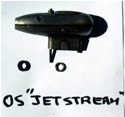
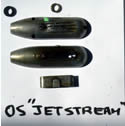
The Jetstream mufflers had 4 components: an
exhaust extension, an inner shell that bolted through to the
engine lugs, two removable baffles, and an outer shell retained
by 3 small Phillips screws. Regrettably, these screws would
vibrate loose and the outer shell, screws and all, would fly
off into the grass, being lost forever. This was really very
sad, because in true OS fashion, these screws and the inner
shell retaining screws were some exotic thread not available
in Australia, then or now. Even to this day I have an OS Max
III 35 and modified Jetstream muffler which I cannot use because
of these mystery threads.
Later OS mufflers, such as that for the “Pet”,
were much more practical, but many were still held on with
a metal strap, which was easily damaged in a crash, becoming
unusable in short order.
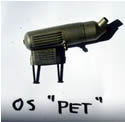
Next on the scene was the Merco 35 muffler,
similarly effective as the Jetstream but much better designed,
in that it did not fall to pieces on the first flight. The
Merco muffler was similar in design to the Jetstream, about
the same size but with an offset exhaust extension. There
were no removable baffles, their place being taken by internal
“crossed baffles”.
Then came the Burford muffler, which I never
owned but was of typically ingenious construction and effective.
I had a later version on my 1968 Taipan 19 which was very
effective: it was also very similar in design to the expansion
chamber mufflers I am promoting here.
Finally, Enya came on board with very practical
but heavy mufflers, usually held on with a very solid metal
strap which abutted the exhaust flanges to eliminate stress
on the crankcase sides.
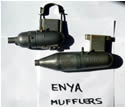 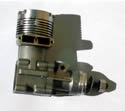
Most of the later Enya stunt size engines, including
the Dykes ring Enya 40 shown in the photograph, had solid
exhaust lugs with side dimples that begged to be threaded,
but weren’t. These were ideal for bolting on a muffler,
but until the Enya SS40, were never used. My own Enya’s
are tapped 1/8 BSW to take, in the first instance, a modified
OS Jetstream muffler, and finally my own Supercool muffler,
of which more anon.
In more recent years, some modellers started
using the so-called “tongue muffler”, which I
confess I do not regard as a muffler at all! I have seen them
bored out with ½” holes, remaining very noisy
exhaust extensions. The version below was given to me, many
years ago, by “Big Art” Adamisin. Only in recent
years did I adapt it to suit my OS20 in a free-flight model,
when I found it quite useful but definitely not quiet.
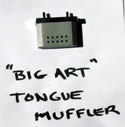
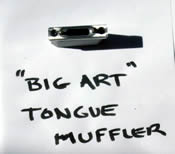
Then in the late 1980’s I became interested
myself in designing mufflers, so it was off to the engineering
section of the libraries to pick the experts brains. I became
aware of words like “expansion chamber”, “Helmholtz
resonator”, “low pass acoustic filter”,
“tuned pipe resonator”, plus lots of heavy equations
which Microsoft “Word” cannot even represent on
paper.
This was all great fun. In time I developed,
from theory and cut-n-try, my own designs, which I attempted
to market. I sold 2, and still have dozens waiting for the
elusive customer to appear. This research was published in
Merv Buckmaster’s “Aeromodelling Digest 1990”,
under the catchy title of “Design Considerations For
Model Engine Mufflers”. I do not propose to cover that
ground again here, but if you want a photocopy of the text,
just send me your address and $5 to 42 Hepburn Way, Balga
6061, WA, Australia.
Moving right along, there are just 2 items I
feel the need to discuss.
First, the design of most commercial mufflers is wrong. They
are made to look pretty, having rounded fronts with tapered
exhaust cones at the rear. Good for gas flow, poor for muffling.
Below in the photos of the Supercool muffler you can see the
correct design: blunt ends with no baffles.
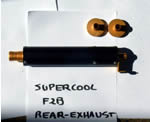

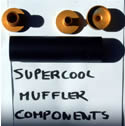
The noise level from this design is set by the
ratio of the muffler body diameter to the diameter of the
exhaust hole. The smaller the exhaust hole, the bigger the
body diameter, the less noisy the expansion chamber muffler.
Note that the gas flows straight through the muffler, no baffles,
no deviations, no perforated pipes etc. The only novelty is
the little pipe sticking out of the baffle/end-piece. This
is related to a small amount of resonant behaviour in the
expansion chamber, as also is the secondary expansion chamber
at the outlet of the muffler. This secondary chamber is called
a low pass filter: it is there to catch some frequencies that
manage to escape the main chamber.

There is not much to be gained with extra compartments,
as in the photo of a test muffler below.

Now for the second design problem. This turns
out to not be related to the muffler at all. Here at Whiteman
Park, there are very loud radio models screaming about; very
loud, even though they have exhaust mufflers. The thing is,
the exhaust is not necessarily the dominant source of sound
from a model engine.
At one time, I tried to silence a Rossi 15 turning
27000 RPM. I made a metre-long muffler full of baffles, just
like a pistol silencer, and hooked that up to the motor. You
could put your ear up to the exhaust end, and all you got
was an ear-load of castor oil for your troubles. No noise
at all: but the sound level meter still registered 102 DBA!
Thinking the prop tip speed of Mach .7 might be the problem,
I fitted a 4-blade small diameter prop. No improvement in
the sound level was apparent. This leaves only noise from
the air intake and noise radiated direct from the motor itself,
none of which I was about to confront.
In a nutshell, if you want to reduce the noise
level, you must also reduce the RPM. This is not too original:
the fact was reported in the AMA publication “Sound
and Model Aeronautics”, 1989.
It is very disappointing to see that model engine
manufacturers are still making low torque, high revving sport
motors for R/C. These motors are inherently noisy: exhaust
mufflers won’t ever silence them.
What is desperately needed are high capacity,
low RPM, low weight engines with effective mufflers. In F2B,
these attributes have been slow in coming, although the current
crop of Russian motors seems to be on the right track.
My ideal F2B engine would be a cross-flow 60
with the same weight, and power of an ST46, but at 6000 RPM.
It would also feature Enya exhaust lugs, Dykes ring; with
accurately parallel and round (better than 1 micron out-of
round) chromed bore. My own 45’s running at 8000 RPM
with Supercool muffler cannot be heard by the pilot if there
is passing road traffic or other engines running.
Now, what possessed me to start writing this?
I forget. But if you got this far along, thanks for visiting
me here in la-la land.
|